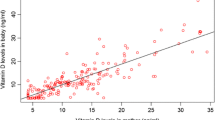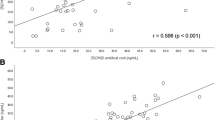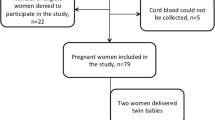Abstract
Vitamin D deficiency is common in Southeast Asia but there are limited data in pregnant women and neonates. This study aimed to determine the prevalence of vitamin D deficiency in cord blood of newborns and the association with maternal vitamin D status. A total of 94 pregnant women and their neonates were included. Clinical data and venous maternal blood for calcium, phosphate, albumin, alkaline phosphatase, magnesium, intact parathyroid hormone (iPTH), and vitamin D (25OHD) were obtained on the day of labor. Cord blood was collected following delivery to evaluate vitamin D status of newborns. Mean serum maternal and cord blood 25OHD levels were 25.42 ± 8.07 and 14.85 ± 5.13 ng/mL. The prevalence of vitamin D deficiency (25OHD < 12 ng/mL) and insufficiency (25OHD 12–20 ng/mL) in cord blood of newborns were 20.2 and 69.1%, respectively. There was a significant correlation between maternal and cord blood vitamin D levels (r = 0.86; P < 0.001). The factors associated with cord blood vitamin D deficiency were low maternal 25OHD level and no vitamin D supplement during pregnancy.
Conclusion: There is a high prevalence of vitamin D deficiency among Thai neonates. Adequate prenatal vitamin D supplementation should be implemented as routine antenatal care.
What is Known: • Vitamin D deficiency is prevalent in Southeast Asia. • There are widespread vitamin D deficiency among Thai populations including pregnant women. | |
What is New: • There is a high prevalence of vitamin D deficiency among Thai neonates. • The factors associated with cord blood vitamin D deficiency are low maternal vitamin D level and no vitamin D supplement during pregnancy. |

Similar content being viewed by others
Abbreviations
- 25OHD:
-
25-Hydroxyvitamin D
- iPTH:
-
Intact parathyroid hormone
- UVB:
-
Ultraviolet B
- VDD:
-
Vitamin D deficiency
References
Chailurkit LO, Aekplakorn W, Ongphiphadhanakul B (2011) Regional variation and determinants of vitamin D status in sunshine-abundant Thailand. BMC Public Health 11:853. https://doi.org/10.1186/1471-2458-11-853
Chailurkit LO, Kruavit A, Rajatanavin R (2011) Vitamin D status and bone health in healthy Thai elderly women. Nutrition 27(2):160–164. https://doi.org/10.1016/j.nut.2009.12.001
Charatcharoenwitthaya N, Nanthakomon T, Somprasit C, Chanthasenanont A, Chailurkit LO, Pattaraarchachai J, Ongphiphadhanakul B (2013) Maternal vitamin D status, its associated factors and the course of pregnancy in Thai women. Clin Endocrinol 78(1):126–133. https://doi.org/10.1111/j.1365-2265.2012.04470.x
do Prado MR, Oliveira Fde C, Assis KF, Ribeiro SA, do Prado Junior PP, Sant’Ana LF, Priore SE, Franceschini Sdo C (2015) Prevalence of vitamin D deficiency and associated factors in women and newborns in the immediate postpartum period. Rev Paul Pediatr 33(3):287–294. https://doi.org/10.1016/j.rpped.2015.01.006
Holick MF (2007) Vitamin D deficiency. N Engl J Med 357(3):266–281. https://doi.org/10.1056/NEJMra070553
Jacquemyn Y, Ajaji M, Karepouan N (2013) Vitamin D levels in maternal serum and umbilical cord blood in a multi-ethnic population in Antwerp, Belgium. Facts Views Vis Obgyn 5(1):3–5
Kovacs CS (2008) Vitamin D in pregnancy and lactation: maternal, fetal, and neonatal outcomes from human and animal studies. Am J Clin Nutr 88(2):520S–528S
Kumar P, Shenoi A, Kumar RK, Girish SV, Subbaiah S (2015) Vitamin D deficiency among women in labor and cord blood of newborns. Indian Pediatr 52(6):530–531
Manzano Varo C, Garcia-Algar O, Mur Sierra A, Ferrer Costa R, Carrascosa Lezcano A, Yeste Fernandez D, Ortigosa Gomez S (2017) Plasma 25-OH vitamin D concentrations in cord blood after summer months, Spain. Rev Esp Salud Publica 91
Marshall I, Mehta R, Ayers C, Dhumal S, Petrova A (2016) Prevalence and risk factors for vitamin D insufficiency and deficiency at birth and associated outcome. BMC Pediatr 16(1):208. https://doi.org/10.1186/s12887-016-0741-4
Munns CF, Shaw N, Kiely M, Specker BL, Thacher TD, Ozono K, Michigami T, Tiosano D, Mughal MZ, Makitie O, Ramos-Abad L, Ward L, DiMeglio LA, Atapattu N, Cassinelli H, Braegger C, Pettifor JM, Seth A, Idris HW, Bhatia V, Fu J, Goldberg G, Savendahl L, Khadgawat R, Pludowski P, Maddock J, Hypponen E, Oduwole A, Frew E, Aguiar M, Tulchinsky T, Butler G, Hogler W (2016) Global consensus recommendations on prevention and management of nutritional rickets. J Clin Endocrinol Metab 101(2):394–415. https://doi.org/10.1210/jc.2015-2175
Nimitphong H, Holick MF (2013) Vitamin D status and sun exposure in Southeast Asia. Dermato-endocrinology 5(1):34–37. https://doi.org/10.4161/derm.24054
Nimitphong H, Chailurkit LO, Chanprasertyothin S, Sritara P, Ongphiphadhanakul B (2013) The association of vitamin D status and fasting glucose according to body fat mass in young healthy Thais. BMC Endocr Disord 13:60. https://doi.org/10.1186/1472-6823-13-60
Parlak M, Kalay S, Kalay Z, Kirecci A, Guney O, Koklu E (2015) Severe vitamin D deficiency among pregnant women and their newborns in Turkey. J Matern Fetal Neonatal Med 28(5):548–551. https://doi.org/10.3109/14767058.2014.924103
Pratumvinit B, Wongkrajang P, Wataganara T, Hanyongyuth S, Nimmannit A, Chatsiricharoenkul S, Manonukul K, Reesukumal K (2015) Maternal vitamin D status and its related factors in pregnant women in Bangkok, Thailand. PLoS One 10(7):e0131126. https://doi.org/10.1371/journal.pone.0131126
Rojroongwasinkul N, Kijboonchoo K, Wimonpeerapattana W, Purttiponthanee S, Yamborisut U, Boonpraderm A, Kunapan P, Thasanasuwan W, Khouw I (2013) SEANUTS: the nutritional status and dietary intakes of 0.5-12-year-old Thai children. Br J Nutr 110(Suppl 3):S36–S44. https://doi.org/10.1017/S0007114513002110
Sachan A, Gupta R, Das V, Agarwal A, Awasthi PK, Bhatia V (2005) High prevalence of vitamin D deficiency among pregnant women and their newborns in northern India. Am J Clin Nutr 81(5):1060–1064
Vinkhuyzen AA, Eyles DW, Burne TH, Blanken LM, Kruithof CJ, Verhulst F, Jaddoe VW, Tiemeier H, McGrath JJ (2015) Prevalence and predictors of vitamin D deficiency based on maternal mid-gestation and neonatal cord bloods: The Generation R Study. J Steroid Biochem Mol Biol 164:161–167. https://doi.org/10.1016/j.jsbmb.2015.09.018
Wacker M, Holick MF (2013) Sunlight and vitamin D: a global perspective for health. Dermato-endocrinology 5(1):51–108. https://doi.org/10.4161/derm.24494
Woolcott CG, Giguere Y, Weiler HA, Spencer A, Forest JC, Armson BA, Dodds L (2016) Determinants of vitamin D status in pregnant women and neonates. Can J Public Health 107(4–5):e410–e416. https://doi.org/10.17269/cjph.107.5629
Acknowledgments
We would like to thank the patients and their families for participation in this study and Dr. Somchit Jaruratanasirikul for her constructive comments on our work and her editing of the text.
Funding
This study was supported by the Panyananthaphikkhu Chonprathan Medical Center research funding.
Author information
Authors and Affiliations
Contributions
KA conceived of the study, participated in its design, analysis and interpretation of data, and drafted the manuscript. PL participated in the design of study, acquisition of data and coordination of the study. All authors read and approved the final manuscript.
Corresponding author
Ethics declarations
All procedures were performed according to the Declaration of Helsinki and approved by the Ethics Committee, Panyananthaphikkhu Chonprathan Medical Center, Srinakharinwirot University. Informed consent was obtained from all individual participants included in the study.
Conflict of interest
The authors declare that they have no conflict of interest and do not have a financial relationship with the organization that sponsored the research.
Disclosure statement
The authors have nothing to disclose.
Additional information
Communicated by Peter de Winter
Rights and permissions
About this article
Cite this article
Ariyawatkul, K., Lersbuasin, P. Prevalence of vitamin D deficiency in cord blood of newborns and the association with maternal vitamin D status. Eur J Pediatr 177, 1541–1545 (2018). https://doi.org/10.1007/s00431-018-3210-2
Received:
Revised:
Accepted:
Published:
Issue Date:
DOI: https://doi.org/10.1007/s00431-018-3210-2




